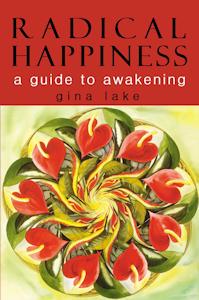We have been talking mostly about what is not real—what the ego produces and pretends is real, such as thoughts, feelings, and desires. What is not real wouldn’t be a problem if it didn’t take us away from what is Real—from this moment, which is where true happiness can be found. What is Real is what is—what is right here, right now, not what is not here right now, such as what should be, could be, or was. What is Real is what is true about this very moment. What is Real is this moment, which is constantly changing into the next moment and the next. What is keeps changing. What complicates this is the fact that part of what is Real in most moments is thoughts. The experience of a thought is real—it’s happening now. However, what happens in the egoic state of consciousness is that a false reality is created by giving our attention primarily to thoughts. When attention is given mostly to thoughts, the rest of reality is overlooked, as if it didn’t also exist. Part of the rest of reality of any moment is the input from our senses: colors, patterns, light, shadow, beauty, warmth, cold, sensations, sounds, tastes, and smells. Moreover, the reality of any moment also includes the essence of who we are: joy, peace, contentment, acceptance, gratitude, and love. Who we are is alive in the moment, and the qualities we exist as can be experienced in any moment. Who we are is joy, peace, contentment, acceptance, and love. When we experience who we are, we feel all these things, and that makes for true happiness. When we experience who we are, we also feel a sense of presence and aliveness because that is how the energy of the Self is experienced. To leave out so much of reality from our awareness by focusing on the egoic mind’s stories or on what is not here in this moment, such as the past and the future, leads to a very limited experience of reality, which feels hollow because it lacks the fullness that is possible. When I say that thoughts and desires are not real, I mean that they are not the whole truth and therefore lack truth. If you had some ice cream and all you could taste was the creaminess and not the flavor, it wouldn’t seem like real ice cream because the full experience of ice cream would be lacking. The same is true when we are identified with our thoughts: The experience of thought is not the complete, full experience of the moment. We miss a lot of reality when we are lost in our thoughts. Just as we can’t enjoy ice cream that only has creaminess, we can’t find real happiness in a moment consumed by thoughts. True happiness can only be found in the fullness of the moment. Any happiness that may come from paying attention to the egoic mind’s limited reality is also limited. If you notice, you will see that happiness is already here. Still, no matter how good life may be, the ego says no to it: “It would be better if….” “I will be happy when….” As long as we don’t follow these thoughts, we will be happy. But usually we give our attention to the ego’s rejection of what is instead of to what is. We give this “no” the power to steer our actions: We jump from one idea to the next, trying to make life and ourselves better. We will never arrive at happiness by listening to the “no.” Happiness just is. It is inherent in the moment—in the now—in the form of joy, acceptance, and love. It can’t not be. We only have to notice what already is. That’s the only reality there is, so why waste your attention on what is not? We think that someday there will be no more “no”—no more ego arguing against reality—and then we will finally be happy. But that day will never come. If you wait for the “no” to disappear, you will be waiting a very long time. We don’t have to get rid of the “no” to be happy; we just have to see it for what it is—the programmed discontent of the ego—and ignore it. The ego will never be happy, but we can be happy if we don’t give our attention to what the egoic mind says we need to be happy. The ego doesn’t know about happiness. What can it know about happiness? Its job is to manufacture unhappiness, and it’s very skillful at convincing us otherwise. Once we see this, the egoic mind has no power to draw us away from the now. The only power it has is the power we give it by believing what it tells us. Now that you see this, there’s no excuse for giving your attention to your thoughts. Pay attention to this moment. Notice. That’s all it takes. The price of admission into the now is attention. This is an easy price to pay because we are always paying attention to something. Attention is one thing that is constant; it’s always happening. Attention is like the eyes of the Self. Where you are placing your attention is where the Self is focusing part of the Awareness that it is. The Self could be described as an awaring presence. It is sometimes simply called Awareness or Presence. Your attention, which is part of Awareness, is directed either by the Self or by the ego. In any moment, the Self may be directing our attention or the ego may be. The Self allows attention to be hijacked by the ego because that experience is part of the Self experiencing this world. Even when attention is being focused by the ego, the Self remains aware of that. Awareness is never lost, but the ego is not aware of Awareness. After awakening, our attention may be briefly captured by the ego, but awareness of the Truth remains. What we put our attention on is what we identify with. Attention directs identification. When we put our attention on thoughts, we become identified with them. And when we notice what else is here, now, in addition to thoughts, identification shifts from the ego to the Self.
|
|||
|
|||


www.advaita.org.uk
Advaita for the 21st Century



Book Extract
Noticing What is Real
Gina Lake

Gina Lake is a spiritual teacher and the author of numerous books. She has a master’s degree in counseling psychology and over twenty years experience supporting people in their spiritual growth. Her website offers information about her books and courses, free e-books, book excerpts, a monthly newsletter, a blog, and audio and video recordings.
Biography
BOOK DETAILS
Publisher: Endless Satsang Foundation
ISBN: 978-0615187679
Format : Paperback
Pages: 204
List Price: £10.50, US$15.95
Where to Buy
AUTHOR DETAILS

